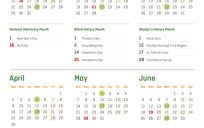Here’s one of the top stories on the U.S. Department of Labor website today:
DOL announces $2.5 million grant to continue to aid Maine workers impacted by Base Realignment and Closure actions [03/01/2010]
It links to the full 200 word press release that ends in a link to a DOL page about National Security Grants. What if, instead of that wording, you read this:
Attention Maine residents! Have you been laid off because your military base was downsized or closed? If so, your state Department of Labor can help. We’ve just given them additional funds to provide job counseling, training, and placement services to citizens who have lost their jobs because Maine’s military bases downsized or closed. To find out how you can take advantage of these services, contact the Maine Department of Labor (with an appropriate link directly to the place where citizens actually can apply for this service – or at least get more information about how to apply).
Short. Sweet. Conversational. Immediately identifies the audience that will care about this news, so the rest of us don’t have to waste our time (and there’s nothing that makes us madder at you than when you waste our time). Quickly summarizes what services are available, and gets us right to the appropriate contact point, in about 60 words. Oh, and it still credits US DOL for the funding. It turns a traditional press release into a service that citizens actually can use. It puts the needs of citizens first, while still giving the agency brownie points. Now, that wasn’t so hard, was it? So why don’t most government agencies take the time to turn their “news” into something we can use?
Last fall, I did a workshop for some public affairs officers at state agencies; and one thing I told them (that they didn’t much like to hear) is that press releases do not make good web content. Not on front pages of government websites. Not on Facebook pages. Not as Tweets. The audience for press releases is the press – not the general public. The general public turns off when it reads something that starts out, “Governor X announced…” or “Secretary Y went to…” They turn off when they see big “hero” photos of appointed officials cutting ribbons or making speeches. When people come to government websites, they’re looking for something that can help them – personally. And they want to know how to get that “thing” as fast as possible. So just take the time to re-write your press release into something we can use.
Oh, and here’s one more tip: show us the money (thank you, Jerry McGuire!). If you want a thumbnail sketch of what citizens are looking for on federal government websites, just visit “What’s On Americans’ Minds” on USA.gov. Check out that section on “pages the public visits most” on the website. See a trend? Yep. Money. How to make money. How to save money. How to get money. How to get more with your money. How to keep your money. This is not rocket science. So if you really want to grab the public’s attention, tell us what you’ve got that can “show us the money.”
I know this isn’t how most public affairs officers have been trained. And I know they face pressure from bosses who want to look good, personally…bosses who like those traditional press releases. But think about it (and explain it to your bosses) this way – if you want people to remember you, give them something they want or need. Put their needs above your needs, and they will remember you.
I always love the “Miracle on 34th Street” analogy. Remember how Macy’s Santa sends the little boy’s mom to Gimbels to get that special toy, even though Macy’s does carry something similar? The camera pans to Thelma Ritter (the mom), and she says something like, “Well, what do you know? Macy’s is putting the spirit of Christmas ahead of profits. I never much liked shopping at Macy’s before, but I will now.”
Turn your news into something we can use. We’ll get better service, and we WILL remember you.
Related Posts
Do the Service – Earn the Image
News Flash! Government Websites Are Not Newspapers




Leave a Reply
You must be logged in to post a comment.